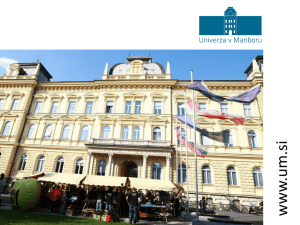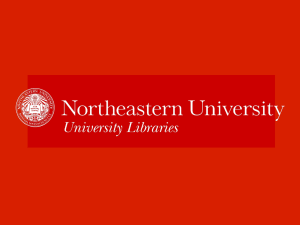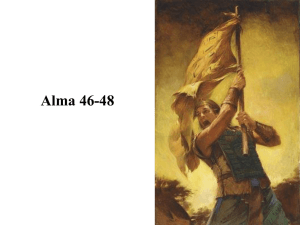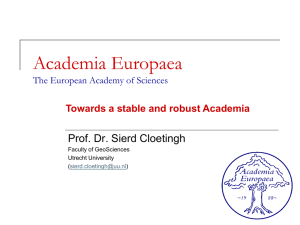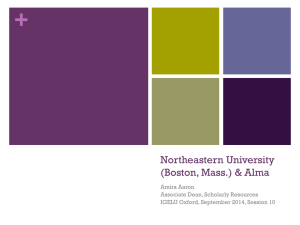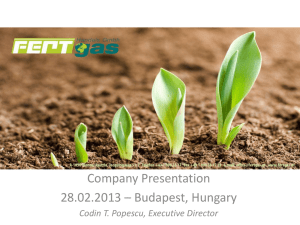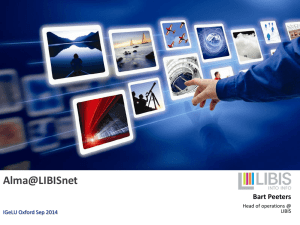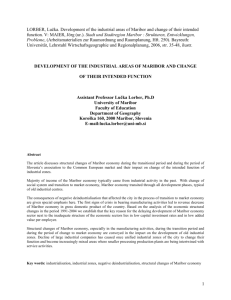ECM, Vice-Rector of Alma Mater Europaea
advertisement
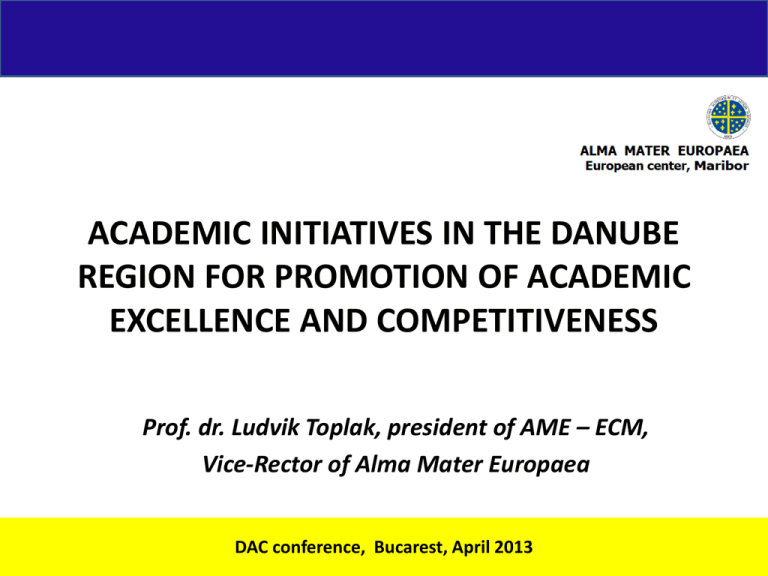
ACADEMIC INITIATIVES IN THE DANUBE REGION FOR PROMOTION OF ACADEMIC EXCELLENCE AND COMPETITIVENESS Prof. dr. Ludvik Toplak, president of AME – ECM, Vice-Rector of Alma Mater Europaea DAC conference, Bucarest, April 2013 ALMA MATER EUROPAEA – EUROPEAN CENTRE, MARIBOR Key facts • The Danube region is a natural, geographical and ecologic area, connected through culture and politics, displaying a large diversity of small nations with long cultural identity which requires a specific approach toward promotion of academic excellence and economic competitiveness in the global world. • The Danube region as a geographic area is connected by water, the environment and respectively energy issues. ALMA MATER EUROPAEA – EUROPEAN CENTRE, MARIBOR Key facts • As a political space we are talking about some 15 – 20 countries with long cultural and political identity, which for this reason requires specific approaches of inter-cultural communication, inter-religious communication. One therefore has to develop instruments of transnational cooperation. • Due to a specific historical and political development of smaller nations, as well as interests of the large nations to manage and influence the territory, today we have to develop political and cultural instruments for recovery with the vision of European identity and in Europe; it is therefore imperative that instruments of transition and European integration are being developed. ALMA MATER EUROPAEA – EUROPEAN CENTRE, MARIBOR Key facts • Due to the demographic trends in the region, as well as migrations, one needs to develop social and health systems. • Regarding formation of new world centres of power with a population of billion people, and the larger nations in vicinity; the Danube region needs to develop specific instruments to enable the smaller nations to follow the needs of modern technologies and the global market, as well as developing academic excellence and competitiveness. Therefore, new educational approaches and public administration and business management are needed as well. ALMA MATER EUROPAEA – EUROPEAN CENTRE, MARIBOR Key facts • The strategic problem of this area has also been recognised by the European Union that during the Hungarian presidency in 2011 approved the so called Danubian Strategy. ALMA MATER EUROPAEA – EUROPEAN CENTRE, MARIBOR Key facts • The strategic problem of this area has also been recognised by the European Union that during the Hungarian presidency in 2011 approved the so called Danubian Strategy. The EU Danube Region Strategy (DRS) is the macro-regional development strategy and action plan for the regions and countries located in the catchment area of the Danube river. It targets the sustainable development of the Danube macro-region as well as the protection of its natural areas, landscapes and cultural heritage. Acting on the request of the European Council in June 2009, the European Commission submitted a proposal for the DRS in December 2010, which was adopted during Hungarian Presidency in 2011. ALMA MATER EUROPAEA – EUROPEAN CENTRE, MARIBOR Academic sphere Initiatives we talked about already at the past two conferences in Budapest and Smolenice: – – – – – – – Danubian rectors conference Alpe Adria rectors conference European Academy of Sciences and Arts Salzburg Danubian Academic Conference Alma Mater Europaea, founded by the Euroepan Academy of Sciences and Arts Alpbach club (as the oldest civil initiative that addresses many Danube-related issues) Institute Donauraum Mitteleuropa (Institute for the Danube Region and Central Europe) – CEEUN – Central and Eastern European University Network – ALADIN (ALpe ADria Innovation Network) – CEEPUS (Central European Exchange Programme for University Studies),… ALMA MATER EUROPAEA – EUROPEAN CENTRE, MARIBOR Academic sphere Other, predominantly political actions of networking in the region at governmental level: - Central European Initiative Trieste, - UNESCO center in Bucarest and - others. Academic connectedness in the area: - Forms of partial economic and technological networking (related to waterways, traffic infrastructure, energy, culture, information systems, academic e-network, libraries e-network and others. ALMA MATER EUROPAEA – EUROPEAN CENTRE, MARIBOR Academic sphere Especially interesting form of cooperation and a large contribution to the development of the academic European identity is given in the form of scientific conferences, such as CONFERENCE ON INTERRELIGIOUS DIALOGUE, organised by the European Academy of Sciences and Arts together with the Austrian institute for religion and peace in 2006 in Maribor. ALMA MATER EUROPAEA – EUROPEAN CENTRE, MARIBOR ALADIN and the EU • European Parliament’s resolution of 21 January 2010 on a European Strategy for the Danube Region stressed the need to involve the relevant regional and local stakeholders in the Danube region. • A message of ALADIN members was sent to members of the EU Parliament declaring interest in actively contributing to the strategy formation process. ALMA MATER EUROPAEA – EUROPEAN CENTRE, MARIBOR Science and Technology International conference: Science and Technology - DIT dr. Juraj Plenković 2013 Opatija, Croatia (28 – 30 June 2013) • It is the 20th, jubilee conference, in honour of its founder, the late prof. dr. Juraj Plenković, • Initiative started in the first years of transition and war in the Balkans • In the last twenty years, over 100 scientists and professors from 30 – 40 Danube region universities would meet in one of the Croatian coastal towns. • The conference is organised by the Croation Communication Association, the World Communication Association and Alma Mater Europaea. ALMA MATER EUROPAEA – EUROPEAN CENTRE, MARIBOR Science and Technology Opatija Conference Sections 1/ Society, Science and Technology 7/ Culture, Religion and Media 2/ E-education and school of the future 8/ Technology and the new world tourism trends 3/ Applied Science and Technology development 9/ Technology of solving social problems 4/ New ICT Technologies 10/ Society, Technology and Ecology 5/ Society and Intergenerational dialogue 11/ Holistic view on Health and Education 6/ Communication management 12/ Archives in intercultural connection the Danubian Region and EU ALMA MATER EUROPAEA – EUROPEAN CENTRE, MARIBOR Conclusion • It is very gratifying and encouraging to see the Danubian Academic Conference getting so actively involved in the development of academic excellence and consequently economic competitiveness, tolerance, peace and education in the Danubian region. All these forms are complementary, contributing to individual segments in the colourful mosaic of the Danube region. • Institutions and projects, related to the Danube issues, have created a large bibliography. Needed now is a joint information system, enabling the smaller cultural identities to preserve their identity and help them develop within Europe and in the global world – connecting the Academies into an information network. • Today’s contradictions during the times of crisis are asking the academic sphere to contribute; in addition to political and economic recovery, we need especially moral and professional recovery. Thank you. Prof. dr. Ludvik Toplak, president of AME – ECM, Vice-Rector of Alma Mater Europaea DAC conference, Bucarest, April 2013
